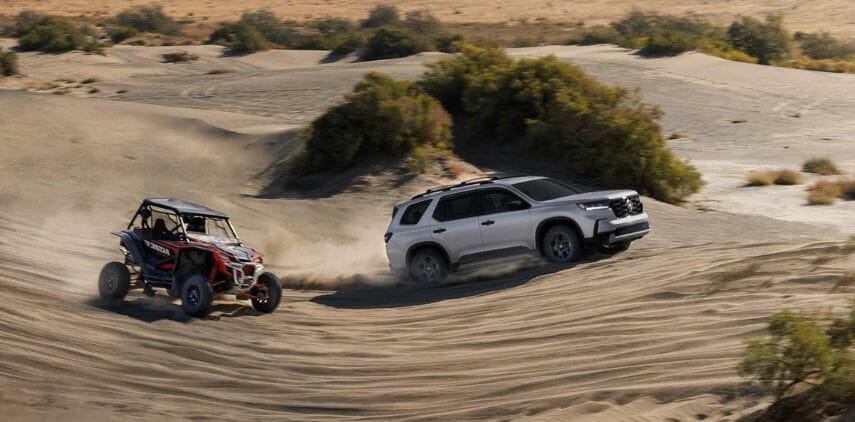Overview
Sport Utility Vehicles, or SUVs, have become ubiquitous on roads worldwide, offering drivers a perfect combination of versatility, off-road capability, and spaciousness. But have you ever wondered where it all began?
The answer to these questions takes us on a thrilling journey through time, from the early days of automobile manufacturing to the modern era of luxury SUVs. Join me as we explore the fascinating story of the first SUV and how it paved the way for one of the most popular vehicle categories today.
Table of Contents
Who Developed the First SUV?
The development of the first SUV is a matter of debate, as the concept of a vehicle that could handle both on-road and off-road driving has been around for decades. However, several automakers like Chevrolet, Jeep, and Ford are credited with introducing early SUVs.
What Was the First American SUV?
The first American SUVs emerged in the mid-20th century when large, rugged vehicles were in high demand. These early SUVs were designed to be versatile and capable of handling a range of off-road terrains while providing a comfortable ride on city streets.
Below is a summary of the first American SUVs and their features:
1. The Chevrolet Suburban Carryall- 1935.
The Chevrolet Suburban Carryall, created in 1935, is considered the first-ever SUV. It was designed to merge the dimensions of a pickup track with that of a car, making it an ideal vehicle for long-distance travel.
The Suburban Carryall boasted many windows, providing ample light and ventilation. It could accommodate up to eight passengers in a 3-2-3 layout, offering a spacious and comfortable ride.
Under the hood, the Suburban Carryall was powered by a 3.4-liter six-cylinder engine that produced 60 horsepower, providing enough power to navigate both on and off-road terrains.
The vehicle also had a large cargo capacity, transporting a lot of luggage, making it perfect for family trips and vacations. Additionally, owners could increase the cargo space by removing the rear seats, adding even more versatility to the vehicle.
2. The Ford Bronco- 1966

The Ford Bronco was introduced as a compact SUV by Ford in 1966. Its first generation was built with a simple and practical design and featured a short wheelbase and solid front and rear axles, making it well-suited for off-road driving.
The Bronco was powered by a 2.8-liter straight-six engine that produced 105 horsepower and 156 lb.-ft of torque. It also came with a three-speed manual transmission as standard, but a three-speed automatic was optional.
The Bronco was initially marketed as a multipurpose vehicle and was available in three body styles: a wagon, a half-cab pickup, and a roadster. The wagon version was the most popular, offering seating for up to six passengers.
The half-cab pickup was a two-seater model with a removable hardtop, making it ideal for outdoor activities. On the other hand, the roadster was designed as a stripped-down version with a minimalistic design, providing a fun driving experience.
Throughout its five generations, the Ford Bronco remained a popular and iconic SUV known for its ruggedness and durability. It was widely used by law enforcement agencies, as well as by off-road enthusiasts and adventurers.
In 2020, after a 24-year hiatus, Ford re-introduced the Bronco as a modern SUV, taking inspiration from the original model and incorporating new technologies and features to cater to today’s market.
3. Jeep Cherokee XJ- 1984
The Jeep Cherokee XJ was first introduced by the American Motors Corporation (AMC) in 1984 and has been regarded as one of the most revolutionary vehicles in the SUV category.
The Cherokee XJ was designed with a boxy and rugged look, making it a popular choice for outdoor and off-road enthusiasts. It was equipped with a 2.5-liter four-cylinder engine with 105 horsepower and a 2.8-liter V6 engine with 115 horsepower.
Later models were also available with a 4.0-liter inline-six engine that produced 190 horsepower.
In addition, this classic Jeep was the first American SUV to offer a unibody design. The body and frame were integrated into a single unit resulting in a lighter, more fuel-efficient vehicle.
One of the critical features of the SUV was its four-wheel-drive system, which made it a capable off-road vehicle. It was equipped with a part-time four-wheel-drive system that allowed the driver to switch between two-wheel and four-wheel drive, depending on the driving conditions.
The XJ was also equipped with a solid rear axle, which provided better traction and stability on rough terrains. It was available in two and four door versions, with the four-door version offering more interior space and practicality.
Was the Bronco the First SUV?
The Ford Bronco, introduced in 1966, is often considered one of the first SUVs. However, the term “SUV” wasn’t coined until the late 1980s, so it depends on how one defines an SUV.
The Bronco was designed as a rugged, off-road vehicle with four-wheel drive and a removable top, making it a popular choice for outdoor enthusiasts and adventurers. It was built on a truck platform with a body-on-frame design, typical of many early SUVs.
While some may argue that other vehicles like Chevrolet Suburban Carryall predate the Bronco, the Bronco was one of the earliest SUVs to gain mainstream popularity. It helped pave the way for the SUV market we see today.
What Was the First 4-Door SUV?
The first 4-door SUV is widely considered to be the 1963 Willys Jeep Wagoneer. It was introduced as a more family-friendly version of the original Jeep with four doors and a longer wheelbase than previous Jeep models.
The Wagoneer was also notable for its luxurious interior, which included power steering and air conditioning features, making it one of the first SUVs to combine off-road capabilities with a comfortable, family-oriented design.
The Wagoneer remained in production until 1991 and was later replaced by the Jeep Grand Cherokee, which continued the tradition of combining off-road capabilities with luxury features in a 4-door SUV.
Did Jeep Invent the First SUV?

While Jeep is often credited with popularizing the SUV, they did not invent the first SUV.
The concept of a vehicle that could handle both on-road and off-road driving has been around for decades, and several automakers have been credited with introducing early SUVs. For instance, the 1935 Chevrolet Suburban Carryall and the 1963 Willys Jeep Wagoneer existed before Jeep invented its first SUV.
However, Jeep is well-known for evolving SUVs into the modern SUVs we know today. For instance, Jeep introduced the Cherokee XJ in 1984, the first SUV to use a unibody construction instead of a body-on-frame design.
This allowed the Cherokee to be lighter and more fuel-efficient while retaining its off-road capabilities. The Cherokee XJ was also one of the first SUVs to offer four doors and a spacious interior, making it a popular family vehicle.
What Was the First Luxury SUV?
Introduced in 1970, the Range Rover is often credited as the first luxury SUV. It was designed to offer the off-road capabilities of a traditional SUV with the refinement and luxury of a high-end sedan.
The original Range Rover had a spacious, comfortable interior, an advanced four-wheel-drive system, and high-quality materials and finishes. It quickly became popular among wealthy and adventurous buyers, and its success paved the way for developing other luxury SUVs.
However, this luxury is credited to Jeep Cherokee XJ, the game-changer in the SUV market. The Cherokee was one of the first vehicles to offer unibody construction, which made it lighter and more fuel-efficient than its body-on-frame predecessors.
The XJ also had a smaller footprint than traditional SUVs, making it more maneuverable and easier to park. While it wasn’t necessarily a luxury vehicle, it did offer a high level of comfort and convenience features for its time.
What Was the SUV That Turned into a Truck?
The SUV that turned into a truck is the Chevrolet Avalanche. The Avalanche was introduced in 2001 and was based on the Chevrolet Suburban platform. It was designed to be a versatile vehicle that could function as an SUV and a pickup truck.
The SUV had a unique mid-gate that could be folded down to extend the truck bed into the cabin, allowing for more oversized cargo. It also had a removable rear window and tonneau cover, which provided flexibility in hauling different types of cargo.
It was produced from 2001 until 2013, and during that time, it received several updates and improvements. However, due to changing market trends and declining sales, Chevrolet discontinued the Avalanche after the 2013 model year.
Conclusion
Overall, the history of the SUV is fascinating and spans several decades. From the rugged vehicles of the past to the modern and luxurious SUVs of today, the SUV has evolved to meet consumers’ changing needs and preferences.
And while the first SUV is a matter of debate, what is certain is that SUVs are available worldwide, offering drivers versatility, off-road capability, and spaciousness.
From the iconic Chevrolet Suburban Carryall to the innovative mid-gate design of the Chevrolet Avalanche, the SUV has continued to evolve and adapt to the changing needs of society.
As we look to the future, it is clear that the SUV will continue to be a popular and influential vehicle in the automotive industry.






